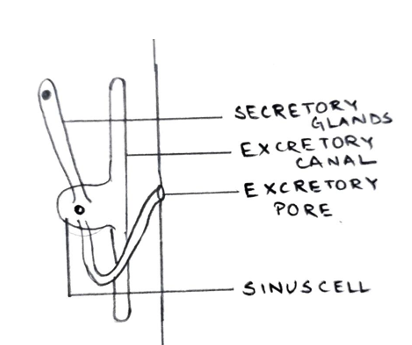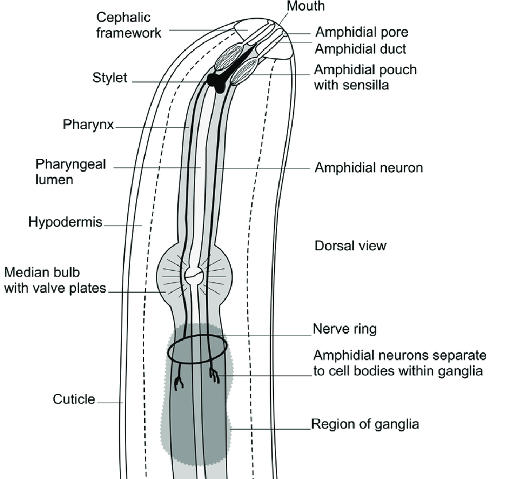🐳 Physiology
Learn about reproductive, excretory and nervous system
Which of the following is correct regarding nematode?
Reproductive System
- The nematodes are generally
dioeciouswhere female and male sexes are separate. - Majority of plant parasitic nematodes do not exhibit any differences as far as body shape. Both sexes are vermiform.
- However, sexual dimorphism is observed in some genera viz., Meloidogyne, Heterodera, Globodera, Rotylenchulus, Tylenchulus and Nacobbus.
- The females of these genera become enlarged and assume different shapes after attaining maturity.
Female Reproductive System
- Three types of reproduction occurring in nematodes are:
- Sexual/Amphimictic reproduction: Fusion of haploid male and female gametes produced by corresponding male and female sexes. Eggs develops into embryo after fertilization.
- Parthenogenetic reproduction: Eggs laid by the female, develop into
embryo without fertilization. Eg.: Meloidogyne sp. - Hermaphroditic reproduction: Haploid male and female gametes either successively or simultaneously are produced from the same gonad and
self-fertilizationoccurs for development of embryo. Each individual act as a bisexual. Eg.: Caenorhabditis elegans
- Female reproductive system in nematode is called female gonad which comprises of two major parts:
- Ovary/ Ovaries
- Gonoduct
Ovaries
- The ovary is terminated by Cap Cells below the cap cell is the Germinal Zone where the germ cells undergo repeated mitosis forming oogonial cells.
- Under favourable environmental condition oogonial cells descend down into growth zone where they become bigger in size by accumulating yolk/deutoplasm called as oocytes.
- Oocytes undergo Meiosis-I (reduction division) in growth zone and further descend down to Maturation/Ripening Zone where haploid oocytes get matured and pass into the gonoduct.
- Based on the number of Ovaries and their mode of arrangement there are different terminologies:
- Monodelphic: Nematode possessing
oneovary. - Didelphic: Nematode possessing
twoovaries. - Prodelphic: If one/two ovaries are anteriorly directed.
- Amphidelphic: If both the ovaries extend towards opposite direction one anterior and one posterior.
- Opisthodelphic: If one/two ovary are posteriorly directed.
- Outstretched: If terminal portion of the ovary/ovaries are straight.

- Monodelphic: Nematode possessing
Gonoduct
- It comprises of
- Oviduct: Oviduct constitutes two rows of cells having a tiny canal within, which controls the passage of matured oocytes into the distal part of the uterus.
- Uterus: Distal part of the uterus is called Spermatheca.
- Vagina: Extension of uterus to outside is a narrow muscular passage called vagina which helps in expulsion of egg to the outside through slit like opening called Vulva/Gonopore.
Male Reproductive System
- Male reproductive system is called Male gonad.
- The male gonad comprising of various parts categorized into three groups: Testis, Gonoduct and Other parts.
Testis
- Based on the number of Testis and their mode of placement in the Pseudocoelom, different terminologies are cited below:
Monorchic: Nematode possessing one testis.- Diorchic: Nematode possessing two testes.
- Monorchic proorchic: If one testis directing anterior.
- Diorchic proorchic: If two testes directing anterior.
- Diorchic opposed: If both the testes extending opposite direction.
- However, in majority of plant parasitic Tylenchid/Aphelenchid nematodes,
Monorchicproorchic outstretches testis is noticed.
Gonoduct
- Gonoduct consists of:
- Seminal Vesicle: It is the dilated part of the gonoduct that act as the permanent store house of the spermatids/spermatozoa.
- Vas deferens: It is a long tube following the seminal vesicle that connects with the rectum. Vas deferens help passage of spermatozoa during mating of male with female.
Accessories Copulatory Structures

- These are secondary sexual organs in male nematodes:
- Spicules: Spicules are a pair of hard, curved tubular secondary sexual organs which are protrusible helps in opening the vulva of female during mating for transfer of spermatozoa into female reproductive system.
- Gubernaculum: Sclerotized boat shape plate like structure located on the dorsal side of spicules which helps to guide the spicules in straight position for easy passage of spermatozoa.
- Caudal alae: It is commonly called Bursa. Caudal alae are a pair of lateral wings like cultivar extension on the tail of the male nematode. Caudal alae help to clasp the female during mating.
- Cloaca: It is the common opening of male reproductive and digestive system and is associated with sphincter muscles.
Excretory System 💩
👉🏻 Two types of excretory systems are present in nematodes:
1. Canalicular Type

- Most of the Tylenchid nematode possess canalicular excretory system
- It has only one lateral excretory canal runs through the lateral hypodermal chord longitudinally with one secretory gland from the sinus cell and another excretory duct that opens to the exterior as excretory pore situated at the midventral line of the body wall at level of nerve ring.
2. Glandular Types

- Primitive unorganized glandular type consisting of a simple specialized gland cell called
Renette Cell. - Found in Adenophorea class.
👉🏻 Functions
- Removal of toxic ammonia or certain fatty acids through excretory canal and ducts.
- Excretory system possesses secretory glands which secretes gelatinous materials in certain nematodes (e.g., citrus nematode) which bind and protect the eggs from abnormal environmental conditions.
- It is also playing important role in osmo-regulation.
- Excretion of toxic substances.
- Secretion of certain chemicals.
- Osmoregulation
Nervous System 🧠
- In plant parasitic nematodes, the nervous system is not well developed. Though they posses very primitive type of nervous system, they also respond to different stimuli.
- The nervous system in plant parasitic nematodes is of two types:
1. Central Nervous System
- Central nervous system refers to ganglionated nerve fibres called
Nerve Ringor Circum Oesophageal Commissure which is called the brain of the nematode. - Nerve ring is usually placed in oblique position with its dorsal side facing upwards and ventral side facing downwards.
- It circles around oesophagus around the isthmus.
2. Peripheral Nervous System
- Located in the periphery which mainly includes body cuticle and also the cephalic and caudal regions.
- The parts of nervous system located are well connected with the
nerve ring(circum oesophageal commisure) which encircles the thumus region of esophagus and are considered to be the most important part of the nervous system (brain of nematode). - The peripheral nervous system includes the sensory organs like:
- Cephalic paillae
- Amphids
- Phasmids
- Deirids

References
- Walia, R. K and Bajaj, H. K (2014). Textbook of Introductory Plant Nematology. Directorate of Knowledge Management in Agriculture, ICAR, New Delhi.
- Ravichandra, N. G. (2019). Plant Nematology. I. K. International Publishing House Pvt. Ltd., New Delhi.
- Dasgupta, M. K. (1998). Phytonematology. Pilgrims Publishing
- Fotedar, D.N. & Handoo, Z.A. (1978) A revised scheme of classification to order Tylenchida Thorne, 1949 (Nematoda). Journal of Science, University of Kashmir (1975), 3, 55–82.
- Qing, X., Bert, W. Family Tylenchidae (Nematoda): an overview and perspectives. Org Divers Evol 19, 391–408 (2019).
- https://doi.org/10.1007/s13127-019-00404-4
- https://nematode.unl.edu/dolichod.htm
- http://www.nematologia.com.br/files/tematicos/6.pdf
Which of the following is correct regarding nematode?
Reproductive System
- The nematodes are generally
dioeciouswhere female and male sexes are separate. - Majority of plant parasitic nematodes do not exhibit any differences as far as body shape. Both sexes are vermiform.
- However, sexual dimorphism is observed in some genera viz., Meloidogyne, Heterodera, Globodera, Rotylenchulus, Tylenchulus and Nacobbus.
- The females of these genera become enlarged and assume different shapes after attaining maturity.
Female Reproductive System
- Three types of reproduction occurring in nematodes are:
- Sexual/Amphimictic reproduction: Fusion of haploid male and female gametes produced by corresponding male and female sexes. Eggs develops into embryo after fertilization.
- Parthenogenetic reproduction: …
Become Successful With AgriDots
Learn the essential skills for getting a seat in the Exam with
🦄 You are a pro member!
Only use this page if purchasing a gift or enterprise account
Plan
Rs
- Unlimited access to PRO courses
- Quizzes with hand-picked meme prizes
- Invite to private Discord chat
- Free Sticker emailed
Lifetime
Rs
1,499
once
- All PRO-tier benefits
- Single payment, lifetime access
- 4,200 bonus xp points
- Next Level
T-shirt shipped worldwide

Yo! You just found a 20% discount using 👉 EASTEREGG

High-quality fitted cotton shirt produced by Next Level Apparel